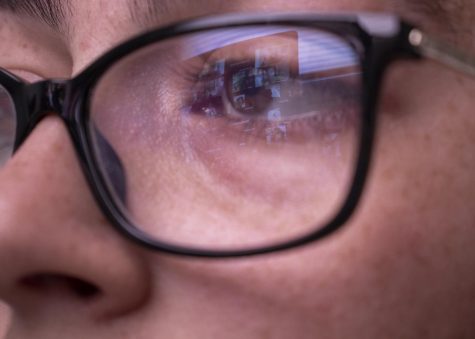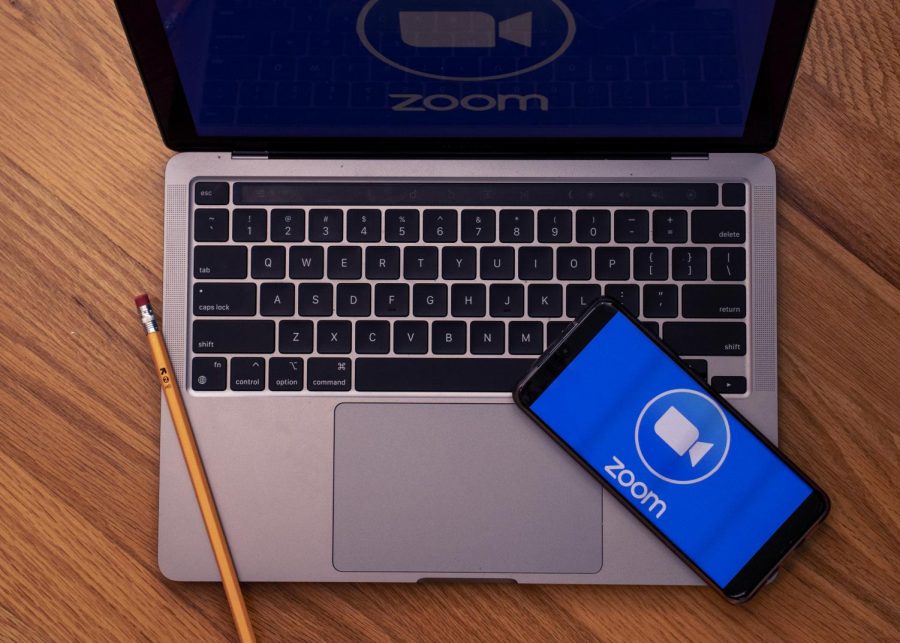Zoom Fatigue: The Physical Impact of Prolonged Virtual Meetings
A laptop and phone sit showing the Zoom logo on Wednesday, September 8, 2021. . (Elizabeth Agazaryan / Xpress Magazine)
It’s a Tuesday, the week has just started, and you’ve been sitting at your desk attending meeting after meeting staring at the familiar blue light from your computer screen. By the end of the day, your eyes are droopy and strained, shoulders tense — common symptoms among those who frequent Zoom or other video conferencing platforms.
Professors, students and remote workers alike are encountering a new and strange form of exhaustion known as ‘Zoom fatigue.’ The onslaught of remote and virtual meetings, brought on by the ongoing COVID-19 pandemic, may have a larger impact on the body than previously thought.
What is ‘Zoom fatigue’ and why does it occur?
“Zoom fatigue often comes about when you’re fatiguing your muscles, and the muscles get strained and they release lactic acid, which irritates the nerve endings,” said Richard Harvey, who has a doctorate in social ecology and professor at the San Francisco State University Department of Recreation, Parks, Tourism and Holistic Health.
“Your posture does matter, how close you are to a screen does matter,” Harvey said. “When you’re looking at a smartphone your head and neck might be down, or when you’re leaning over a computer because you haven’t adjusted the height of the screen, you’re going to increase muscle tension in certain locations.”
Many other scholars and researchers in this field also provide arguments to support this. In August 2021, The University of Auckland, New Zealand published a research paper titled, Why do we have Zoom fatigue and what can we do about it? The article examines the common causes and cures for this broadening issue.
“As time flies, we tend to be unaware that our muscles slightly tighten, our breathing quickens and is shallower,” the study found. “Our blinking rates decrease and our posture slouches forward as we bring our nose close to the screen to see the text more clearly.”
Because of this pattern of muscle tension and poor posture, we may also become unaware of the discomfort after a prolonged period of time.
“We anesthetize ourselves,” Harvey said, emphasizing how most individuals have now become unaware of the physical impact fatigue has on their body. “We are past the point where our body protects itself and numbs out all that discomfort.”
The inherent function of office and computer work has been known to cause these physical problems in long-term workers. The increased screen time has further highlighted the issue with the way we work.
“There’s no way to sit ergonomically in front of a laptop,” said Erik Peper, doctorate in psychology and San Francisco State professor. “We tense our shoulders, and we don’t even know it. By the end of the day, our shoulders are tight.”
Digital overstimulation
In addition to the physical fatigue and muscle tension, many may also experience mental exhaustion from digital overstimulation. With the ever-present nature of screens and electronic devices in our society, researchers suggest it can be easy to fall into this predicament.
“We forget that it takes over us, and we still have all our other responsibilities,” said Peper. He further emphasizes the analysis of personal digital use and consumption, such as on social media platforms or streaming services.
Peper continued, “You only have 24 hours in a day, and account for sleep. So, what we end up doing is sleeping less.”
Fast-paced work and school environments paired with the ongoing pandemic create a recipe for digital overconsumption, making it harder to organize or separate work from play. However, researchers suggest it may be beneficial to address personal abilities.
“Some people are overscheduling,” said Harvey. “If the meetings are back-to-back, there is a hazard there. It’s hazardous to have no breaks or pauses. We always have to look at hazards, problems, toxicity, in relation to the individual’s sensitivity, ability to adapt and vulnerability.”

Why is remote communicating and learning harder for certain individuals?
Newly developed research shows that remote communication may be difficult for certain individuals because it differs from the natural and instinctive modes we have used throughout human history. We miss out on one of the most important conversational aspects — nonverbal social signals. These can include facial expressions, hand gestures, or eye contact.
The 2021 academic paper, Avoid Zoom Fatigue, Be Present and Learn, published by the International Society for Neuroregulation & Research, provides insight into learning habits through Zoom and other remote communication platforms. Researchers surveyed 325 undergraduate students participating in remote learning, which found 94% had “moderate to considerable difficulty with online learning.”
“The absence of social facial and body feedback often makes teaching and learning more challenging,” researchers found.
With the usage of Zoom, you miss significant social cues which are replaced by digital body language, essentially the headshot view of your fellow meeting goers.
“Texting is another asynchronous method of communication,” Peper said. “But when we are talking verbally, you receive immediate feedback.”
Remote forms of communication, by nature, are less engaging and interactive than in-person meetings. This format often makes it harder for the fundamental conversational and social cues to get relayed.
“You don’t see the expressiveness of the full-body,” Harvey said. “There is ambiguity and uncertainty there.”
Adaptive capacity
The complexity and process of coping with stress and fatigue in the new digital age exists on a spectrum. In other words, some individuals may be more or less disadvantaged for remote learning.
“The technical term here is adaptive capacity, and some people do not have the ability to adapt, they may be ultra-sensitive to micro-adjustments,” said Harvey. “It really does depend on a number of factors and components, it’s not one size fits all.”
The sudden shift to remote communication, coupled with various outside forces such as internet connection, home life distractions, and COVID-19 related life changes, would easily cause disorder in any individual’s routine. Some, however, may be more inclined to handle these changes.
Harvey emphasizes the need for adaptation for many remote workers, as well as reorganization of personal and professional habits for long-term well-being.
“The bigger question is how do you decide what is going to work for you and figure out the right rhythm and the right pace,” Harvey said. “Each one of us has a better time for writing, a better time for eating, a better time for exercising and so on. We can pay better attention to our own internal cues and signals as we move throughout the day.”

Nicole Gonzales (they/them) is the current online editor for Xpress Magazine. They are a fourth-year journalism student minoring in sociology and political...












